|
In Search of the Hutsul Koliada of Kryvorivnia by Virlana Tkacz |
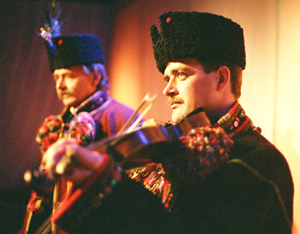 Yara Arts Group, which I direct, is a resident company at La MaMa Experimental Theatre. We create modern theatre pieces for New York audiences. Perhaps because I live in the era of the ever-new, instant and disposable, I am fascinated with the presence of the past in our lives and search for ways of making its presence a visceral force on stage. Trying to touch the past, I have created a show about water with Nina Matvienko and another based on the similarities we noticed between our own theatre dreams and those of actors working in Ukraine in the 1920s. I also made a whole series of theatre pieces with my Buryat colleagues based on legends that invade our lives. To collect these legends I traveled to remote villages in Siberia, Mongolia and China and listened to endless hours of storytelling and song. I have also spent several beautiful summer weeks in Ukrainian villages recording traditional songs and stories that resulted in several Yara shows. But in preparation for Yara’s Koliada show at La MaMa, for several years I headed in the dead of winter high up into the Carpathian Mountains.
Yara Arts Group, which I direct, is a resident company at La MaMa Experimental Theatre. We create modern theatre pieces for New York audiences. Perhaps because I live in the era of the ever-new, instant and disposable, I am fascinated with the presence of the past in our lives and search for ways of making its presence a visceral force on stage. Trying to touch the past, I have created a show about water with Nina Matvienko and another based on the similarities we noticed between our own theatre dreams and those of actors working in Ukraine in the 1920s. I also made a whole series of theatre pieces with my Buryat colleagues based on legends that invade our lives. To collect these legends I traveled to remote villages in Siberia, Mongolia and China and listened to endless hours of storytelling and song. I have also spent several beautiful summer weeks in Ukrainian villages recording traditional songs and stories that resulted in several Yara shows. But in preparation for Yara’s Koliada show at La MaMa, for several years I headed in the dead of winter high up into the Carpathian Mountains.
I first traveled together with photographer Alexander (Sasha) Khantaev to the village of Kryvorivnia to record the Hutsul koliada in January 2003. Although I had spent my childhood caroling with my local Plast group in Newark, I was totally unprepared for what we witnessed in Kryvorivnia. After church on Christmas over 80 men (yes, all men) dressed in traditional winter outfits sang a koliada I had never heard. Then they split up into eight groups of ten, each with a fiddler and followed their lead singer in the group’s favorite song as they circled the church. Afterwards, each group headed to the first home in their allotted part of the village. Sasha and I followed one group that had trembitas, mountain horns made of pine and birch that are over ten feet long. We headed up a steep trail, sinking deep into the snow. I could barely keep up. Finally, the group stopped outside a home. First, the horns announced our presence.
Then the group started singing:
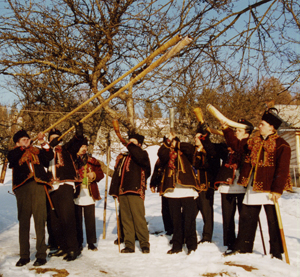 Is the master home?
Is the master home?
We all know he’s home
He is sitting at the head of the table
At the head of the table made of maple
And his table is beautifully set
Beautifully set with braided breads
With braided breads made of spring wheat
On his table are three jugs
The first jug holds sweet mead
The second jug holds dark beer
The third jug holds green wine*
The song continued on. Each verse was followed by the refrain “Oh, Lord may it be so.” The master of the house came out and invited the group into the home. We were obviously expected, the room was set up with tables covered with food. The koliadnyky sat against one of the walls -- all in a line with their lead singer in the center. They then sang a long song to the master, afterwards they sang another to the lady of the home. A separate song followed to each of the children. These were lengthy songs, many over twenty minutes, one almost forty minutes. That day I heard a beautiful epic story about a dashing young man who rides a raven black horse around Kryvorivnia turning down gold and silver, but accepting the hand of a fine young lady. I also heard one about how the sun, moon and fine rain come to visit the mistress of the house. I was enchanted, but puzzled. What did any of this have to do with the story of Bethlehem? Eventually, I learnt that the koliadas are part of a winter ritual that now coincides with Christmas, but is much older in its origin, traditions and symbolism.
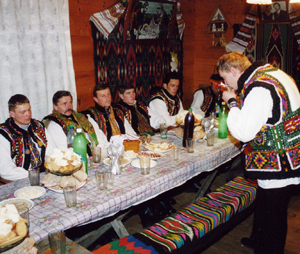 This ritual was considered to be the most important event of the year, since people believe that the spring would not come to the village unless these songs were sung in every household to every person. Each song was chosen specifically for the person. Songs to the master of the house would be about prosperity and hard work, while those to the lady of the house, about skill and diligence. Songs to a young man would be about heroic deeds, courage, strength and good looks, while those to a young woman would be about a great beauty capable of magical feats. These songs were actually incantations that assumed the magical power of words: what is said will be so. Their striking poetic images were intended to secure the described qualities.
This ritual was considered to be the most important event of the year, since people believe that the spring would not come to the village unless these songs were sung in every household to every person. Each song was chosen specifically for the person. Songs to the master of the house would be about prosperity and hard work, while those to the lady of the house, about skill and diligence. Songs to a young man would be about heroic deeds, courage, strength and good looks, while those to a young woman would be about a great beauty capable of magical feats. These songs were actually incantations that assumed the magical power of words: what is said will be so. Their striking poetic images were intended to secure the described qualities.
Beautiful Hutsul koliadas were collected by ethnographers at the end of the 19th and beginning of the 20th century in this region. Today, most people assume that these ancient songs are no longer remembered in the mountain villages. But, the tradition survived over fifty years of Soviet persecution and has recently experienced a revival. Lesia Turyanska, who had been recording traditional music in the Carpathians since the 1960s, first told us about the Hutsul koliada, and arranged for us to stay in Kryvorivnia with Hanna Hotych, a local teacher. We arrived on Christmas Eve, as the preparations for dinner were in full swing. The ritual meal included twelve dishes. I had read that traditionally, before the family sat down to this dinner the master would feed a little of each dish to the household animals. Then he would circle the house three times with the food and invite sorcerers, thunder, storms, wolves, bears and foxes to dinner. After repeating his invitation three times he would say: “If you don’t want to come and taste all our delicious dishes and tasty drinks, if you won’t come when we invite you, then don’t come when we don’t call you!” He then would invite to dinner the spirits of the dead and those lost on the road or at sea.
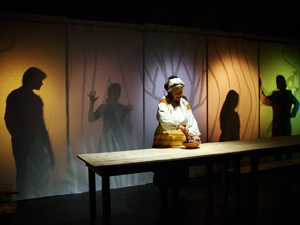 A special place would be set for these spirits at the table and the dishes would remain on the table overnight in case the spirits came late. I assumed these beautiful details of the ritual could now only be seen in movies, but to my great surprise Hanna’s youngest son, Mykhilyk, headed out with a bowl filled with a taste of each dish to the shed where he fed the bull. Slavko then carried some of the dinner to a relative. Ivan, the oldest son, took another bowl, covered it with a braided bread and circled the house inviting Nature to dinner.
A special place would be set for these spirits at the table and the dishes would remain on the table overnight in case the spirits came late. I assumed these beautiful details of the ritual could now only be seen in movies, but to my great surprise Hanna’s youngest son, Mykhilyk, headed out with a bowl filled with a taste of each dish to the shed where he fed the bull. Slavko then carried some of the dinner to a relative. Ivan, the oldest son, took another bowl, covered it with a braided bread and circled the house inviting Nature to dinner.
During my stay in Kryvorivnia I was struck by how many of the rituals we witnessed were attempts to bring together the present with the past and to create a greater community that would include all the living (both human and animal), the spirits of the ancestors and forces of nature. All would have to come together to create the next harvest and a bountiful future. This thought inspired Yara’s theatre piece, Koliada. We started working on the piece in Kyiv with Yara and Kyiv actors, as well as several koliadnyky from Kryvorivnia. We presented a workshop of the piece at the Les Kurbas Center in Kyiv in December, as the future of Ukraine was being created in the square right outside our theatre.
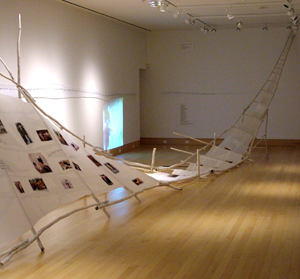
The koliada in Kryvorivnia also inspired us to create an exhibit at La MaMa Galleria. The exhibit included photographs of the koliadnyky Alexander Khantaev took in Kryvorivnia and a short video called “The River Flows” that Andrea Odezhynska created using some of the material we shot in the village. Watoku Ueno created an installation, a frozen stream of wood and paper on which Andrea’s video was shown. Eventually, this led to our installation project Still the River Flows that opened the second floor exhibit space of the Ukrainian Museum in New York. We have also invited contemporary artists to respond to the ancient koliada texts and have arranged two exhibits of their art at the Ukrainian Institute of America in New York.
Yara created four shows centered on the Koliada, including Twelve Dishes (2005), Still the River Flows(2008), Winter Sun (2010) and Midwinter Night (2012) all of which performed at La MaMa. We are currently working on bringing Midwinter Night to Toronto where it will be performed at Enwave Theatre of Harbourfront Center December 27-29, 2013.
For more on Yara's Midwinter Night
For more on Yara's Koliada events
*translations of the Hutsul Koliadas by Virlana Tkacz and Wanda Phipps
BRAMA, Inc.
Copyright (c)1995-2013 Yara Arts Group; all rights reserved.
Photos by Watoku Ueno, Alexander Khantaev and Makoto Takeuchi
|